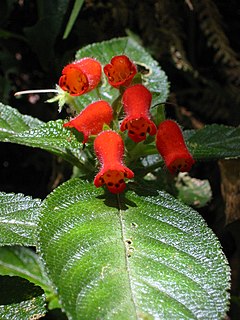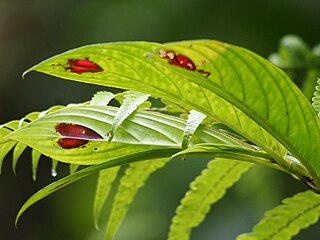
Gloxinia is a genus containing three species of tropical rhizomatous herbs in the flowering plant family Gesneriaceae. The species are primarily found in the Andes of South America, but Gloxinia perennis is also found in Central America and the West Indies, where it has probably escaped from cultivation.

Columnea is a genus of ca. 200 species of epiphytic herbs and shrubs in the flowering plant family Gesneriaceae, native to tropical America and the Caribbean. The tubular or oddly shaped flowers are usually large and brightly colored – usually red, yellow, or orange – sometimes resembling a fish in shape. A common name is flying goldfish plants due to the unusual flower shape.

Kohleria is a New World genus of the flowering plant family Gesneriaceae. The plants are generally tropical herbs or subshrubs with velvety stems and foliage and brightly colored flowers with spots or markings in contrasting colors. They are rhizomatous and commonly include a period of dormancy in their growth cycle. The genus was revised in 1992 and was then recognized as having 19 species distributed in Central America and South America. [Phylogenetics|phylogenetic]] in 2005 indicated that the epiphytic genus Capanea is derived from within Kohleria, and the two species of Capanea were subsequently transferred to Kohleria. The genus Pearcea is closely related.

Seemannia is a New World genus in the flowering plant family Gesneriaceae. There are four species in the genus, primarily found in the Andean regions of South America. The name honors the German botanist Berthold Carl Seemann.

Pearcea is a South American genus of 17 species of tropical herbs in the flowering plant family Gesneriaceae. It is classified in tribe Gloxinieae and is closely related to the genus Kohleria, in which some of its species were previously included. The genus Parakohleria has recently been synonymized under Pearcea, a conclusion later supported by molecular analyses that showed that Pearcea hypocyrtiflora was nested within the former Parakohlerias.

Sinningia is a genus of flowering plants in the family Gesneriaceae. It is named after Wilhelm Sinning (1792–1874), a gardener of the Botanische Gärten der Friedrich-Wilhelms-Universität Bonn. There are about 65 species of tuberous herbaceous perennials, all occurring in Central and South America, with the greatest concentration of species occurring in southern Brazil.

Columnea consanguinea is a species of flowering plants in the genus Columnea. They are endemic to Colombia, Costa Rica, Ecuador, Nicaragua, and Panama. They are distinctive for possessing red translucent heart-shaped markings on their leaves that serve to attract their main pollinators - the hummingbird Heliodoxa jacula - to their more inconspicuous flowers.

Caroxylon is a genus of shrubby flowering plants in the family Chenopodiaceae, found in drier areas of the Old World, including southern Africa, Madagascar, northern Africa, Mediterranean islands of Europe, the Canary Islands, Socotra, Ukraine, Russia, western Asia, Central Asia, India, western and northern China, and Mongolia.
Xylosalsola is a genus of flowering plants belonging to the family Amaranthaceae.
Amalophyllon is a genus of flowering plants belonging to the family Gesneriaceae.
Cobananthus is a genus of flowering plants in the family Gesneriaceae, with a single species Cobananthus calochlamys. It is sometimes included in the genus Alloplectus, but molecular phylogenetic studies suggest that the two genera are not closely related, with Cobananthus more closely related to Alsobia.
Rufodorsia is a genus of epiphytic flowering plants in the family Gesneriaceae. The genus name refers to the reddish back of the upper lobes of the flower. The relationship of Rufodorsia with the genus Oerstedina is uncertain, as of April 2021. It is native to montane cloud forest in Central America.
Oerstedina is a genus of epiphytic flowering plants in the family Gesneriaceae, native to Mexico, Costa Rica and Panama. The relationship of Oerstedina to the genus Rufodorsia is uncertain, as of April 2021.
Gloxiniopsis is a genus of flowering plants belonging to the family Gesneriaceae.
Gloxinella is a genus of flowering plants belonging to the family Gesneriaceae.
Eucodonia is a genus of flowering plants belonging to the family Gesneriaceae.
Mandirola is a genus of flowering plants belonging to the family Gesneriaceae.
Neomortonia is a genus of flowering plants belonging to the family Gesneriaceae.
Sphaerorrhiza is a genus of flowering plants belonging to the family Gesneriaceae.
Pyankovia is a genus of flowering plants belonging to the family Amaranthaceae.







